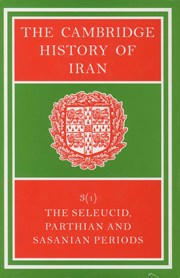Book contents
- Frontmatter
- Introduction
- PART 1 POLITICAL HISTORY
- PART 2 NUMISMATICS
- PART 3 IRANIAN HISTORICAL TRADITION
- PART 4 IRAN AND HER NEIGHBOURS
- Bibliography
- Plate section
- Plate section
- Plate section
- Map 3. The western regions of the Sasanian empire">
- Map 11. The Silk Road from China to the Roman Orient
- References
Introduction
Published online by Cambridge University Press: 28 March 2008
- Frontmatter
- Introduction
- PART 1 POLITICAL HISTORY
- PART 2 NUMISMATICS
- PART 3 IRANIAN HISTORICAL TRADITION
- PART 4 IRAN AND HER NEIGHBOURS
- Bibliography
- Plate section
- Plate section
- Plate section
- Map 3. The western regions of the Sasanian empire">
- Map 11. The Silk Road from China to the Roman Orient
- References
Summary
This volume encompasses a time span of about one thousand years, from the emergence of the Seleucid empire in 312 B.C. to the collapse of the Sasanian empire in A.D. 651. The period saw the rise and fall of three mighty dynasties, the Seleucids, the Arsacids, and the Sasanians, as well as the formation of a number of states and empires to the east, notably the Greco-Bactrian kingdom and the Kushan empire. In the religious sphere the millennium witnessed the expansion of gnostic tendencies in western Iran and Mesopotamia, culminating in the appearance and spread of Manichaeism; the consolidation of Zoroastrianism under the Sasanians as an authoritarian state Church; and the birth and suppression of the egalitarian movement of the Mazdakites. In more general terms, the era saw the ascendency and demise of Hellenism in Iran; the development of a distinct Iranian art-style with wide impact; the evolution of a national saga; the development of local systems of writing in the major provinces; and finally, the shaping of an administrative system and court procedures which were to play an important role in the 'Abbasid caliphate and its eastern vassal states.
THE HISTORY OF THE PERIOD
Seleucus, one of Alexander's generals, seized Babylon in 312 B.C. and forged a large empire which included most of western Asia. The eastern provinces of the empire, however, where the Parthians, Bactrians, Sogdians and Chorasmians lived, did not remain long in the possession of the Seleucids, slipping away from their hold when the satrapies of Bactria and Parthia aspired to sovereignty. The defection in 246 B.C. of Diodotus, satrap of Bactria, marked the beginning of a new dynasty, the Greco-Bactrian, which gradually expanded southward, occupying the Kabul valley, the Peshawar region, and Taxila in the Punjab.
- Type
- Chapter
- Information
- The Cambridge History of Iran , pp. xvii - lxxviPublisher: Cambridge University PressPrint publication year: 1983
References
- 2
- Cited by

